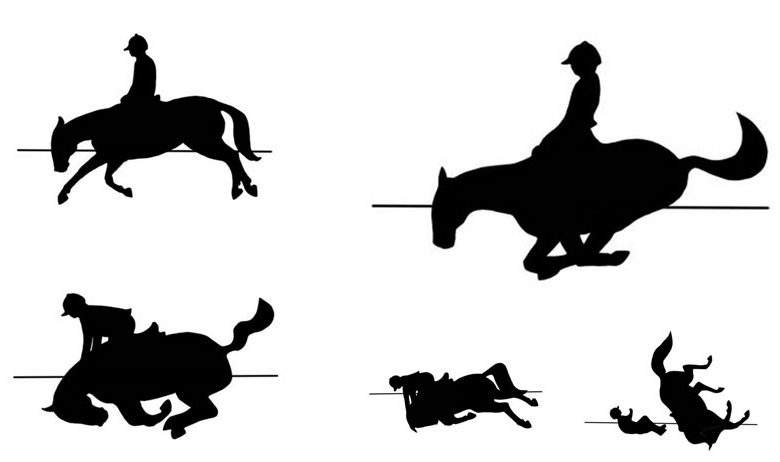
Position and aids: training to be safe
Any rider with little riding experience can recall from memory their falls or near falls. Some may be funny, some may even be spectacular, but some are not. In general, falling from a horse can be painful, and at times a rider will sustain serious injury such as broken bones, lacerations and bruises. Most of the time riders suffer nothing serious.
Unfortunately, there are times when a fall can be much worse. There is a type of fall, that often causes severe damage. This fall is called the rotational fall. It is the kind of fall that causes serious injury to the rider and also to the horse-notably to the cervical part of the horse’s spine.
This type of accident happens when a horse trips on one of its front feet. Unable to regain its balance, the horse falls over its own chest and at that moment throws the rider forward. The horse could, depending on its speed, involuntarily tumble over the rider as it somersaults over its own back. The consequences of this type of fall can be tragic independent of the use of safety equipment.
Any type or breed of horse, as well as any equestrian sport is subject to this type of accident. The horse can be well mannered, hot, in competition or on a trail ride. All it takes for such event to happen is a false step that triggers this rotational fall reaction.
In order to avoid a catastrophic event, we must first learn about our natural reactions, and then understand how they affect our interactions with the forces of physics involved. We must also accept that our natural reactions are counter intuitive and that we must re-condition our bodies to help us avoid a disastrous result.
In a Rotational Fall, the natural reflection of riders, when they notice that the horse is about to fall, is to grab the reins and lean forward with the chest. The rider’s natural instinct is to pull on the reins to try and bring the horse back up. Except that at the moment the horse trips and loses its balance on the front, its natural instinct as it hits its chest on the ground, is to automatically forward its chin at the time of impact which would prevent its body from tumbling over itself. It would also at the moment of the impact use its lower neck muscles to help bring its withers back up. However, if the rider blocks the horse’s natural instincts by holding on to the reins, the horse is blocked from forwarding its neck and it is limited physically by the reins, and it is left with no choice but to put its nose behind the vertical and somersault. When it falls forward with its neck shortened, the chances of the horse re-establishing its balance is compromised and the tumble is the mechanical consequence. The force of this chain reaction is also aggravated by the speed of the horse.
In this same instance, the force the rider applies to the reins while in the forward body position, it will help project the body of the rider even more forward increasing the center of gravity of both rider and horse catapulting the rider in front of the horse. This puts the rider in an extremely vulnerable position and in the path of its mount. The rotation of the fall will also cause physical damage as it will hyperflex the horses poll and squeeze the base of its neck, which can cause severe lesions to this area as well as ligament tears or bone fractures.
In order to prevent a rotational fall, we must look at two fundamental ideas, and unfortunately, they are completely unnatural for a rider.
- When the horse loses its balance in the front, the rider must let go of the reins. As this will help the horse to balance its head and neck and forward its chin. This way, if the horse hits the ground, the chin will prevent its body from tumbling over itself. We must condition ourselves to not balance the horse with the reins. This is usually impossible as we are conditioned otherwise, but it is the only way to prevent a rotational fall.
- When the rider feels that a horse is losing its balance, the rider must try to lean back and wait for the horse to recover and rebalance itself. If a fall does happen the chin will hit the ground first and the rider will be behind the body of the horse and not in front. This un-natural reaction will give the horse the best chance to recover its balance, and re-establish itself.
The bottom line is that the best way to avoid a rotational fall is to do the opposite of what our bodies tell us to do. You must let go of the reins and lean back. This will help prevent a tragic outcome and it will also save lives. Rotational falls often result in grave injuries and sometimes are fatal.
Telling your body to let go of the reins and to stay back may be un-natural, but it must be a reaction that we must condition our bodies to, and it must be taught to all riders in all equestrian disciplines. This is a topic that must be addressed, taught, and prioritized as this is an important safety element of any equestrian sport.
Text by: Andre Ganc
Images by: Jordan Banks
Translation by: Tania Radda
